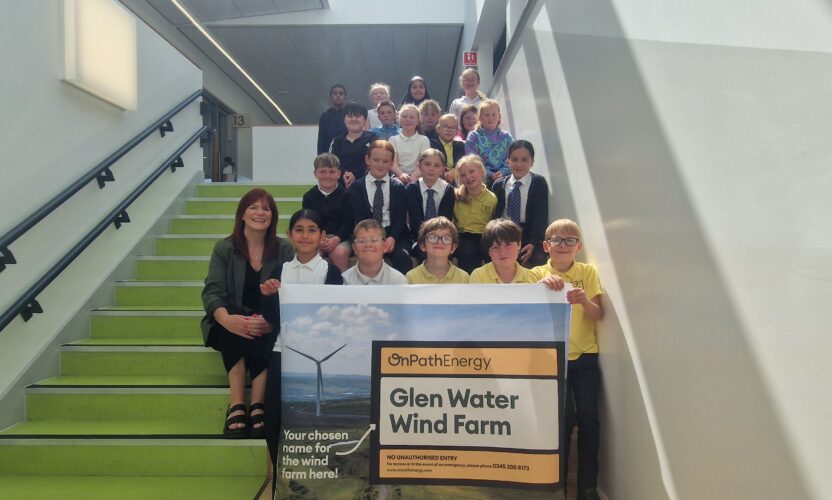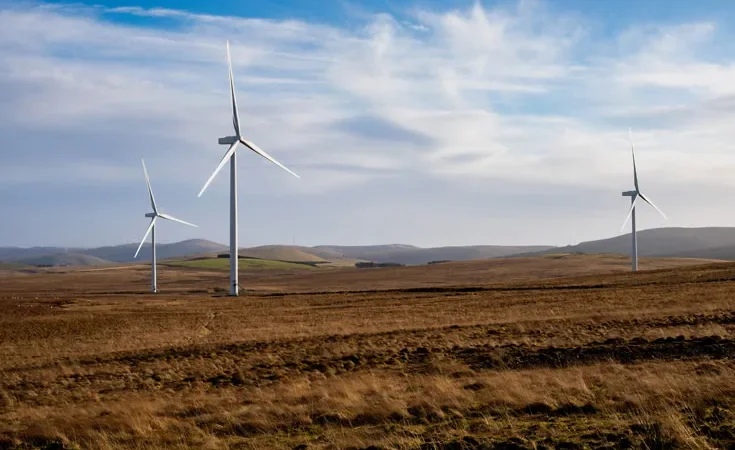
Young minds power up proposed wind farm with new name
It’s been a joy to spend time in each of the three schools, hearing the children’s ideas and seeing how much thought they put into…
 Middle Muir Wind Farm
- South Lanarkshire
Middle Muir Wind Farm
- South Lanarkshire
The above evidence suggests the whole renewable, planning and electricity distribution systems should be reformed to realise the UKs commitment to the legally binding net-zero targets.
BLOG from William Rust, graduate development planner at The Banks Group.
The UN Climate Change Conference (COP27) is just over the horizon, as such we reflect on key takeaways and considerations of COP26 which took place in Glasgow from 31st October-12th November 2021.
What are we doing now?
Banks Renewables has been delivering sustainable renewable electricity generation projects since the early 2000s, from initial site finding and planning, all the way to operating large scale onshore wind farms.
The Banks Group’s development with care approach all projects are developed with sensitivity and consideration for local communities, natural habitats and the environment. Banks operational wind farm portfolio demonstrates this point in practice, with thorough habitat management plans implemented across sites with the overarching aim of conserving and enhancing environmental gains and habitats across the site. For example, planting trees and hedgerows or restoring valuable peatland to ensure local wildlife can sustainably co-exist with wind turbines. Healthy peatlands bring multiple environmental benefits such as providing habitat for biodiversity and also regulating ecosystems by storing carbon.
Banks projects also provide a comprehensive community benefits package to support local community groups, voluntary organisations and environmental initiatives ensuring that the local community shares in the benefits that our projects deliver.
These community packages provide support to a wide range of community projects creating positive lasting benefits that otherwise may not have been resourced. Increasingly these community packages are used in collaboration with the local authority and others to tackle big issues that the communities are facing such as job creation and skills through our Connect2Renewables programme, or helping the community to make its own contribution to help tackle climate change and reduce energy costs with projects such as community decarbonisation supporting renewable energy generation on community buildings, energy efficiency measures, planting more trees to help absorb CO2 and providing strategic additions to the resources an area needs to thrive and grow.
The above examples represent some of the many benefits facilitated throughout the operational lifetime of the ever-growing Banks Renewables portfolio of developments. This demonstrates how Banks Renewables is helping to tackle climate change by investing in more renewable energy projects that also enable natural habitats and the environment to flourish. The Banks Group’s development with care principles can be seen throughout the Banks Renewables’ portfolio as the company aims to create lasting socio-economic benefits within the communities nearby.
Banks Renewables Lambs Hill Wind Farm (operational since January 2017), which consists of four turbines with an installed capacity of 10MW and provides annual electricity for 5,750 homes. The project creates social benefits across various aspects of the community. Over the 25-year operational lifetime, a community fund of around £250,000 is available for local projects and initiatives including a £2,100 grant given to Stillington & Whitton Parish Council towards installing a defibrillator. Annual business rates of £88,000 are paid to Stockton Borough Council, contributing to funding services and initiatives within the local authority. Finally, approximately £1,000,000 was spent with local companies and contractors during the construction of the wind farm, providing local people with work and investing significant money within the local economy.
Currently, Banks Renewables own and operate ten onshore wind farms, totalling approximately 223MW of clean, green electricity every year, with more projects totalling over 800MW in the development pipeline. This demonstrates the clear contributions Banks Renewables is making towards UK national net zero targets and renewable deployment/generation targets. These projects will displace millions of tonnes of carbon from the grid system over their lifetime. Banks Renewables’ ten operational wind farms generated a total of 426,132MWh in 2021. This is the equivalent of powering approximately 146,942 homes per annum; or the equivalent of taking approximately 36,315 petrol cars off the road. Within the 2021 calendar year, these assets displace the equivalent of 89,487.72 tonnes of C02 per annum, representing the clear contributions these assets make to the environment at a national level.
COP + energy security strategy
In practice, the Banks Renewables portfolio makes tangible contributions to many of the agreed global outcomes of COP26, such as the global coal to clean power transition statement, the global forest finances pledge and renewable energy. Banks Renewables’ assets make clear national contributions to net zero targets and domestic renewable electricity generation targets.
The Energy Security Strategy was published on 7th April 2022, and this reaffirms the UK Government commitments to indigenous renewable energy generation since COP26, accompanied with ambitious targets. Offshore wind and solar were the key focus, with the Government targeting roof top individual and commercial solar to increase five-fold by 2035 to 70GW. Interestingly the strategy recognises onshore wind planning policy in England as the cheapest form of renewable generation but offers no change in stance in relation to the onshore wind regime. This represents the lost opportunity to accelerate the transition to net zero carbon generation while also maximising the cheapest form of renewable generation for security of electricity supply.
The planning system
The planning system facilitates the permission for all development types within the UK including renewable infrastructure. Therefore, it is vital the planning system reflects the contemporary needs to complement the legislative requirements of net zero targets. Scotland 2045 – fourth National Planning Framework (Hereby reference NPF4) – consultation draft was published in November 2021. This policy document sets out the core spatial strategy throughout Scotland to 2045, including green energy, quality homes, travel, and waste. Policy 19 – green energy, promotes the clear ambition regarding the deployment of renewable developments. Local authorities are recommended to ensure an area’s full potential for electricity and heat from renewable sources are achieved, focussing also on the repowering and extension of existing onshore wind developments.
Banks Renewables’ current portfolio and pipeline reflect this policy with Kype Muir Wind Farm Extension currently undergoing construction work and Lethans Wind Farm Extension currently within the planning system and due to be determined by the Energy Consents Unit by the end of the year.
The English National Planning Policy Framework supports renewable and low carbon developments within Policy 14 to meet the needs of climate change as renewable energy developments are not required to prove the need of the development, and if the positives outweigh the harms the application should be approved. In practice wider political interventions act as a major barrier to renewable barriers, as part of the Conservative 2015 manifesto a written ministerial statement from the secretary of state for communities and local government, they have set new criteria for onshore wind developments in England, as it stands creating an onshore wind embargo through the planning system.
Necessary infrastructure such as battery storage provides stability to the grid by helping to balance supply and demand, storing energy when demand is low and releasing electricity when demand is higher delivering critical efficiencies to the National Grid. However, battery storage is widely recognised as crucial for balancing the grid, increasing the efficiency of renewable electricity developments and the transition to net zero. Therefore, battery storage infrastructure should be given more weight within planning decisions.
We must work hard to ensure that decision makers, such as councillors that have the power to determine large applications that are not determined by delegated powers, are aware of the benefits renewable/low carbon developments provide.
Capacity and resource factors also prove to be a current barrier to reaching the ambitious targets set. As the number of renewable energy planning applications increase, the capacity of local authority planning teams to determine them does not increase due to a lack of resources and understaffing. Resulting in longer determination periods in line with the increasing technicality of many proposals.
In conclusion, multiple practical and theoretical recommendations should be employed to overcome the current barriers to renewable deployment within the planning system and make significant contributions to renewable deployment within the UK. The key recommendations discussed further below are landscape capacity studies, practical resourcing issues and wider strategic planning and grid reform.
Within both England and Scotland, eliminating some of the key unnecessary structures to deployment such as landscape capacity studies which would help increase deployment. Protecting the intrinsic value of important landscapes is vital, though as the need for an indigenous renewable electricity supply increases, planning policy should increase the capacity for gaining planning consent. English planning policy should be levelled up with the Scottish Framework. Firstly, the current onshore wind development embargo should be lifted; onshore wind is widely recognised as the cheapest form of renewable energy generation. Consequently, this could lead to a greater indigenous supply of renewable electricity within England while also making positive contributions to the current cost of living crisis. Onshore wind also delivers deep and broad benefits for communities through the supply chain and benefit funds for the areas hosting developments.
Moreover, increasing Government spending within the planning system to upskill and provide more capacity to keep up with the growing demands would help greatly. With the determination periods of commercial renewable infrastructure applications increasing, the pressure of failing national renewable targets also grows. Therefore, a means of reducing determination periods should be introduced. Fast-tracking determinations for large proposals would be a step in the right direction, though there are wider challenges faced by the renewable energy industry, i.e. the lack of capacity within grid infrastructure. We are already seeing numerous projects being put on hold or delayed due to the grids current inability to keep up with the demands of renewable energy development.
Despite COP appearing favourable in terms of the deployment of renewables and combatting climate change, regional structures such as the planning system and capacity of the national grid are clear barriers to reaching net zero. Therefore, strategic changes and the necessary investments are fundamental in overcoming these barriers and getting back on track for carbon neutrality within the UK. Consequently, there is a clear gap between the political ambitions of renewable deployment and what is practically possible under the current regime due to the barriers within the planning system and the grid. If these issues are not addressed, it could inhibit the UK from reaching its net-zero ambitions and targets.
The above evidence suggests the whole renewable, planning and electricity distribution systems should be reformed to realise the UKs commitment to the legally binding net-zero targets. This blog aims to raise awareness regarding the key constraints to renewable deployment and how these constraints could be overcome. We urge you to read our other environmental posts and importantly, support renewable energy infrastructure applications in your area. Letters of support are powerful when determining applications, especially when they come from local residents. Commercial scale renewable infrastructure often provides a package of community benefits to fund initiatives within the local area and contribute significantly to national-level net-zero targets.
[1] https://ukcop26.org/cop26-goals/
[2] https://soils.environment.gov.scot/resources/peatland-restoration/
[3] https://www.gov.scot/publications/scotland-2045-fourth-national-planning-framework-draft/
[4] https://www.gov.uk/government/publications/national-planning-policy-framework–2

It’s been a joy to spend time in each of the three schools, hearing the children’s ideas and seeing how much thought they put into…

We are committed to maximising the benefits of our projects, from supporting local businesses during construction to reinvesting in communities through our OnPath Together approach…

Thanks to the funding we have received, combined with the community’s dedication and fundraising success, we have been able to transform it into a space…